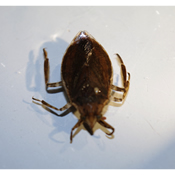|
|||||||||||||||||||
| Distinguishing Characteristics | |||||||||||||||||||
|
|||||||||||||||||||
| Additional Pictures | |||||||||||||||||||
| Ecology | |||||||||||||||||||
| Distributed throughout North America, there are 500 different species within the family. Larvae and adults range in length from 6-65 mm. The preferred habitat is vernal pools, ponds, slow moving streams, lakes, and swimming pools. Belostomatidae prey on small insects, salamanders, tadpoles, fish, and snails.
Their appearance is usually tan brown and with an overall oval shape to their body. They use their flattened hind legs for swimming, in a paddle like manner. A bite from a Belostomatidae is extremely painful and can cause permanent damage. They are fierce and powerful predators that stalk their prey then inject poison through a thin pointed beak. These digestive enzymes then break down and liquify tissue and muscle to then be sucked out. The longer the bite is held, the worse the lesion becomes. When they encounter something larger than themselves, like a human, they pretend to be dead, and even ooze out a fluid from their anus. This act makes the other predator believe that Belostomatidae in actuality is dead and then Belostomatidae strikes and bites. Although Belostomatidae is a great predator it's an even better parent. After an extensive mating ritual that involves sparing with their front legs and elaborate dances under water; the female then deposits eggs on the males back. The female deposits eggs on the males dorsal side from caudal end until the whole back is covered. The male frequently interrupts this process, slowing the process down so it can take anywhere from twenty seconds all the way up to twenty minutes. The male takes care of the eggs and leaves them on his back until they are ready to hatch. There are three different types of brooding techniques that the male can use. The first is surface brooding. This is where the male will bring his back with the eggs to the surface of the water exposing him and the eggs to predation. The next process is brood pumping. This occurs below the water surface and resembles the display pump used in mating rituals. Lastly he can do brood stroking. This is where the male takes his hind legs and brushes water over the eggs on his back. All of these techniques are done to increase embryonic respiration. The eggs will not hatch if left on their own. Multiple females can mate with the same males and multiple clutches can be placed on one male's back. Females have also been known to get rid of other clutches previously laid on the males back before depositing her own. If a male is under stressful conditions and needs to abort the clutch, he can use his legs to kick off the clutch. Males have also been seen tapping the clutch on their backs and it is believed they are checking to see if the eggs are still there on their backs. |
|||||||||||||||||||
| QuickTime Movies | |||||||||||||||||||
| Additional Links | |||||||||||||||||||
| Bibliography | |||||||||||||||||||
|
|||||||||||||||||||


